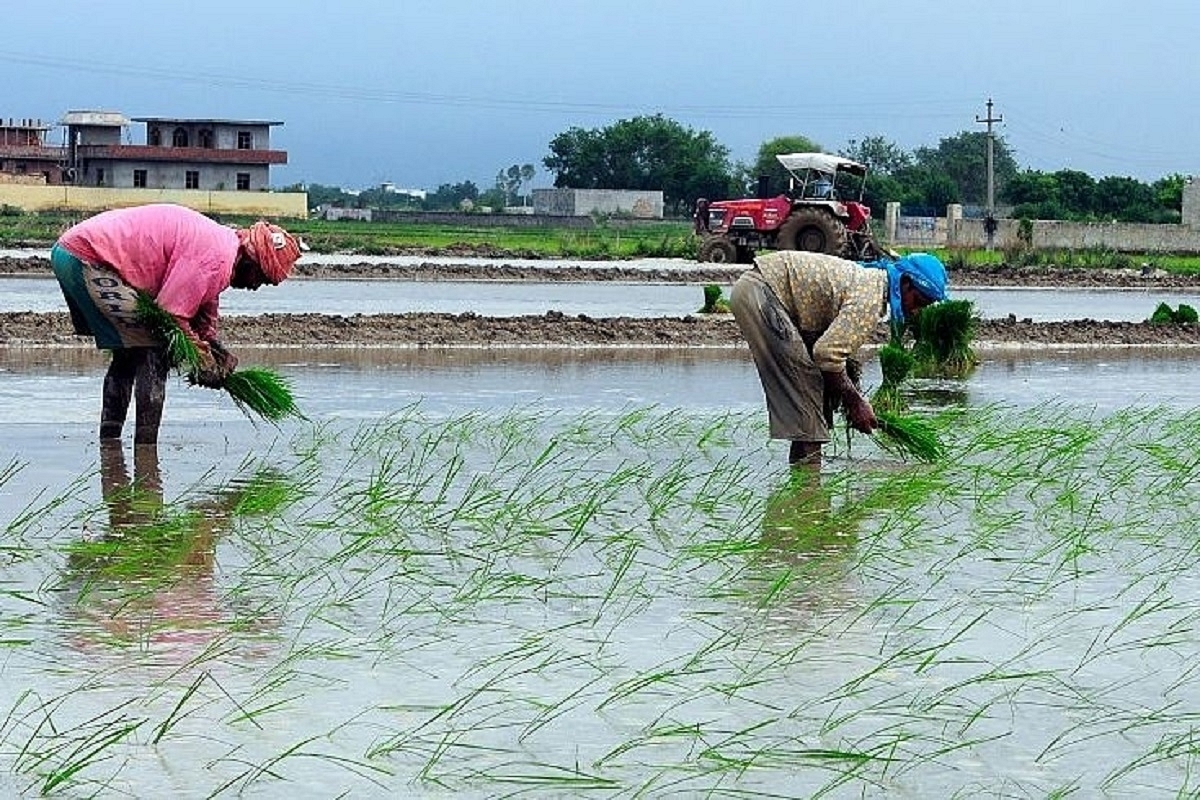Ideas
Doubling Farm Incomes Needs Faster Job Creation, Not More MSP, Subsidies
- Doubling or even quadrupling of farmers' per capita income over the next few years requires the modernisation of agriculture and the creation of non-farm jobs has to move forward at a rapid pace.

Farm workers at a paddy field.
After the annulment of the three farm laws enacted in 2020, agriculture continues to be outside the domain of liberalisation and globalisation. On the other hand, some of the protesting farmers' organisations are seeking a legislative guarantee for the minimum support price (MSP) for produce.
India's experience and that of international commodity agreements have amply demonstrated that administered pricing is not an effective policy instrument for augmenting producers' income. Doubling or even quadrupling of farmers' per capita income over the next few years requires the modernisation of agriculture, and the creation of non-farm jobs has to move forward at a rapid pace.
In 1966-67, to tide over the food crisis, an MSP for wheat was introduced as an incentive to farmers to boost production. Since then, MSPs have been extended to 23 crops — wheat, rice, pulses, oilseeds and commercial crops of raw jute, cotton and sugarcane, among others. In addition, subsidies are given to farmers by central and state governments on fertilisers, power, credit, irrigation, and crop insurance which account for over 2 per cent of gross domestic product (GDP). And agricultural income is exempted from taxation.
Big farmers have been the major beneficiaries of MSP and subsidies or exemptions. Moreover, despite the subsidies, most farmers live a fragile economic life and the relative gap in per capita incomes of the population engaged in agriculture vis a vis that engaged in other sectors of the economy has widened from 1:2.3 in 1950 to 1:5.3 in 2019. Productivity in most agricultural crops is 20-50 per cent lower than the world average.
Nevertheless, the main cause of the widening gap between agricultural and non-agricultural incomes and the plight of farmers is not the lower productivity but rather the 50 years of slow industrial growth and the consequent slow absorption of agricultural labour. This has led to the accumulation of surplus labour (disguised unemployment) in agriculture on a massive scale.
A few points need to be stressed here. MSP above the market price is not sustainable. It will fuel inflation and suppress private investment in agriculture. MSP and subsidies on fertiliser, credit, power etc, have neither been nor are a solution to the plight of small and poor farmers. Keeping agriculture within bounds of the existing highly regulated and controlled trade and investment regime can push the Indian economy as a whole back to the old era of low growth.
The Indian economy is polarised between a highly productive and globally integrated formal sector and the low productivity sector comprising most of agriculture and informal non-agricultural activities.
In seeking a solution to the plight of farmers, and seek a doubling, trebling or quadrupling farmers' incomes over the next few years, the central policy issue is related to the surplus labour in agriculture. While 10 to 15 per cent of the total workforce will be enough for modern agriculture in India, 50-55 per cent is currently engaged there. The main challenge facing India hence is that of sucking out more than 80 per cent of the workforce engaged in agriculture and absorb them productively in other sectors.
According to McKinsey Global Institute, India needs to create 90 million non-farm jobs between 2023 and 2030 for achieving average annual growth rate of 8-8.5 per cent. In my view, to absorb the surplus agriculture labour and achieve growth rates of over 8 per cent, India needs to create more than 16 million non-farm jobs annually over the next 20 years. This will also require formalising the informal sector and integrating agriculture into a globalising world economy.
For achieving the twin objectives of GDP growth and non-farm jobs creation, modernisation of agriculture, including food processing and other value added services, is as important as labour-intensive and export-oriented industrialisation and making India a global hub for manufacturing and technology services.
Linked to these two processes are a number of other tasks such as the Make in India programme, the development of smart cities, fast-tracking privatisation, developing high quality physical and social infrastructure, achieving 100 per cent literacy, including digital literacy, strengthening of the social security and welfare schemes, and providing an efficient and transparent governance.
With progress in these fields at an adequate pace, MSP and agricultural subsidies, including agricultural income tax exemptions, will become progressively less relevant, even politically.
Support Swarajya's 50 Ground Reports Project & Sponsor A Story
Every general election Swarajya does a 50 ground reports project.
Aimed only at serious readers and those who appreciate the nuances of political undercurrents, the project provides a sense of India's electoral landscape. As you know, these reports are produced after considerable investment of travel, time and effort on the ground.
This time too we've kicked off the project in style and have covered over 30 constituencies already. If you're someone who appreciates such work and have enjoyed our coverage please consider sponsoring a ground report for just Rs 2999 to Rs 19,999 - it goes a long way in helping us produce more quality reportage.
You can also back this project by becoming a subscriber for as little as Rs 999 - so do click on this links and choose a plan that suits you and back us.
Click below to contribute.
Latest